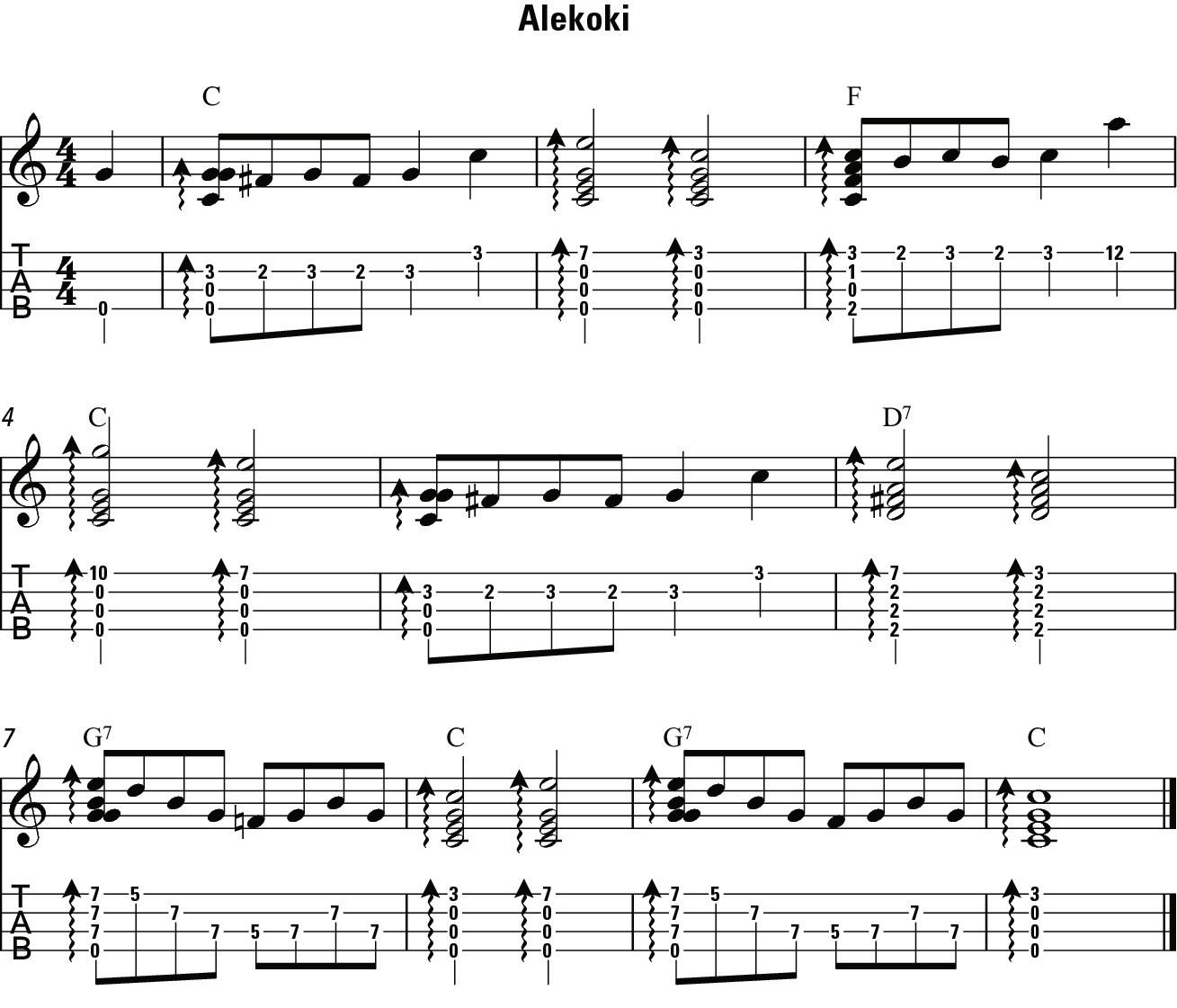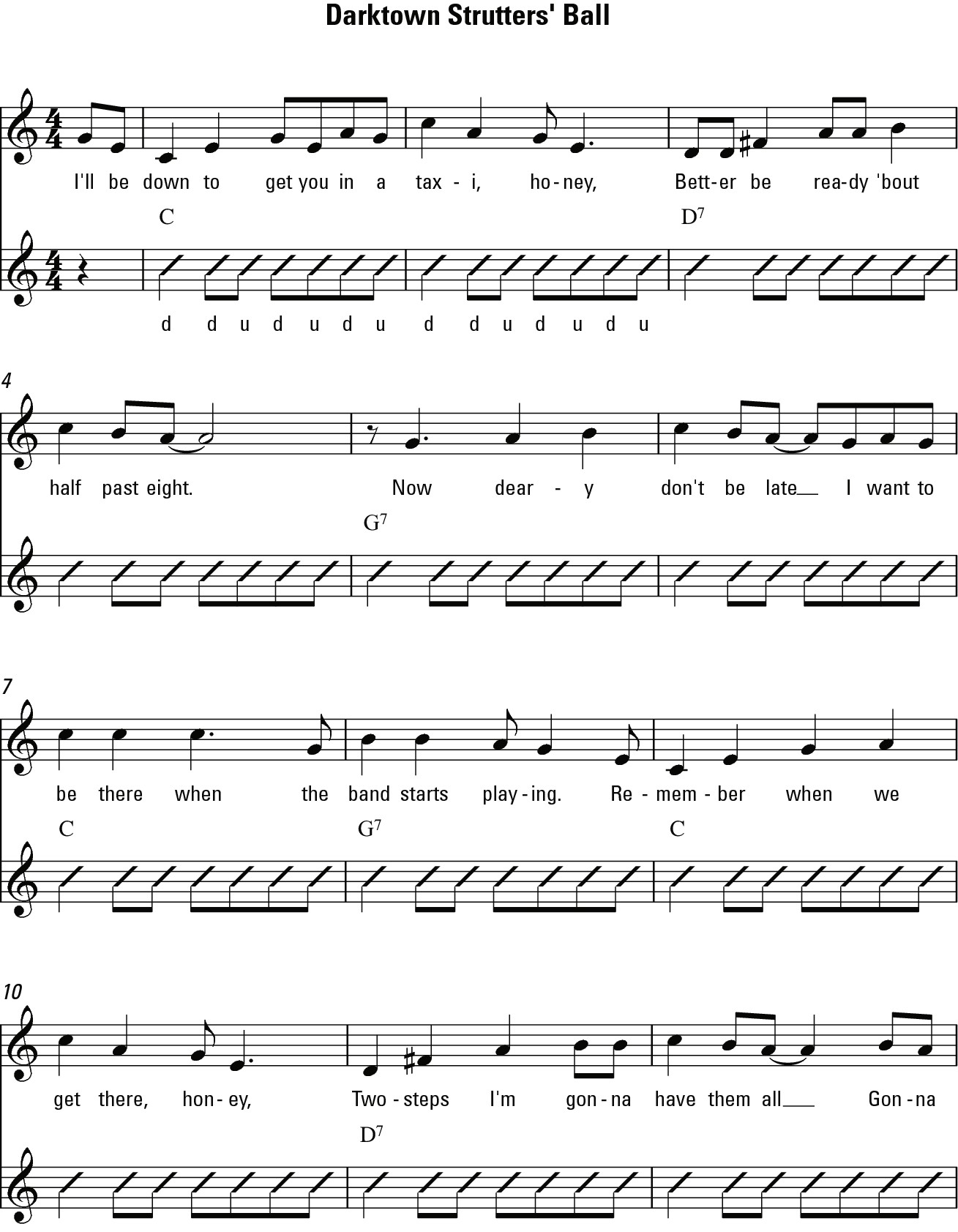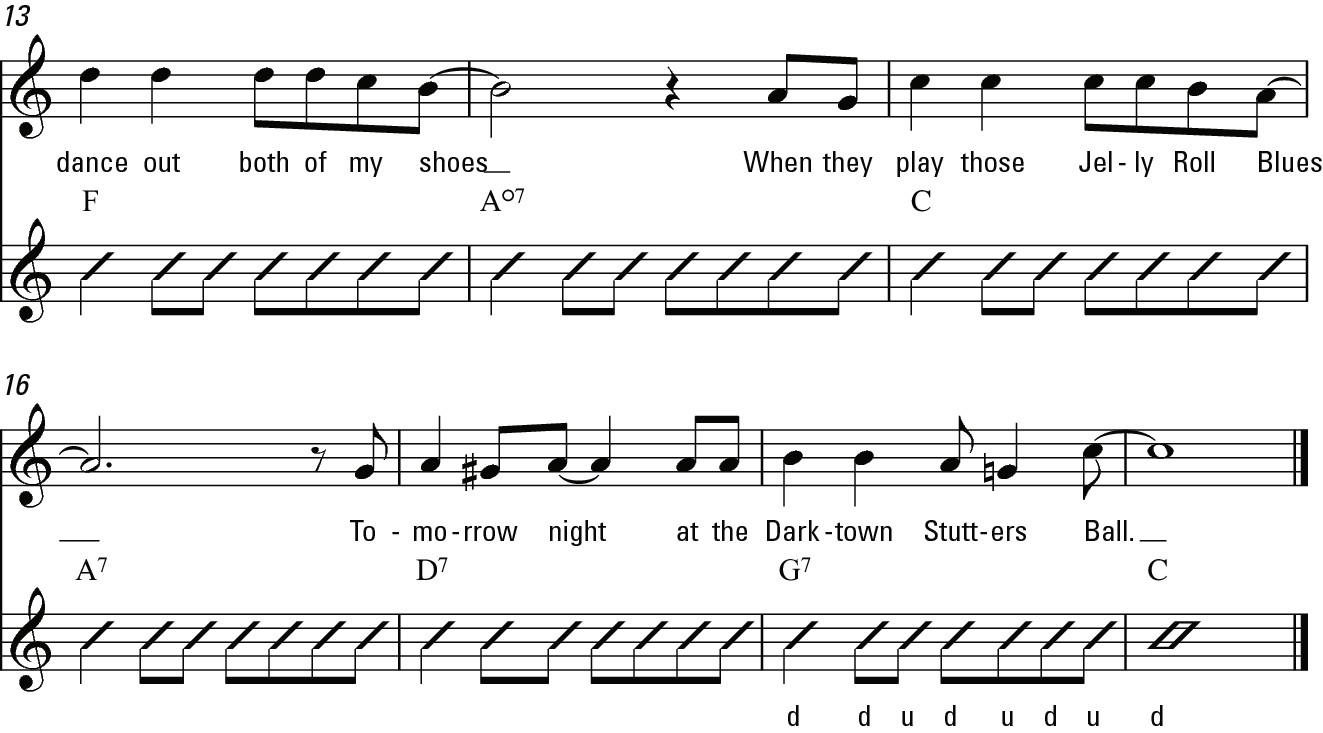Ukulele For Dummies (56 page)
Read Ukulele For Dummies Online
Authors: Alistair Wood
 Hawaiian music has some of the most beautiful tunes ever written, and none is quite as beautiful and lilting as âAlekoki' (see Figure 13-10 and Track 79). It was originally written by William Charles Lunalilo, but later adapted by King Kalakaua and Lizzie Alohikea. The tune has some of the key features of Hawaiian music, including the lilting tempo and the inclusion of an II7âV7âI chord progression (D7âG7âC) that I describe in the earlier section âTurning Around, Hawaiian-style'.
Hawaiian music has some of the most beautiful tunes ever written, and none is quite as beautiful and lilting as âAlekoki' (see Figure 13-10 and Track 79). It was originally written by William Charles Lunalilo, but later adapted by King Kalakaua and Lizzie Alohikea. The tune has some of the key features of Hawaiian music, including the lilting tempo and the inclusion of an II7âV7âI chord progression (D7âG7âC) that I describe in the earlier section âTurning Around, Hawaiian-style'.
Figure 13-10:
âAlekoki' tab.

Watch out for two challenging sections in this piece: you need to do a big jump in bar three and the big stretch in bar six can be tricky.
 To help make the jump easier, cut the previous note slightly short to give yourself time to get up to the 12th fret. If you're playing this piece on a tenor ukulele and find the stretch in bar five too much, use the alternative bar shown in Figure 13-11.
To help make the jump easier, cut the previous note slightly short to give yourself time to get up to the 12th fret. If you're playing this piece on a tenor ukulele and find the stretch in bar five too much, use the alternative bar shown in Figure 13-11.
Figure 13-11:
âAlekoki' alternate bar six notation.

Chapter 14
Jazzing Up Your Uke Playing
In This Chapter
 Adding jazzy turnarounds
Adding jazzy turnarounds
 Jazzing up your chords
Jazzing up your chords
 Strumming up some jazzy tricks
Strumming up some jazzy tricks
 Faking fancy soloing
Faking fancy soloing
T
he ukulele became huge on the US mainland after the Panama-Pacific Expo of San Francisco in 1915 (where the Hawaiian display was the hit of the show). That event was slap bang at the start of the so-called Jazz Age in the US and the new jazzers leapt onto the ukulele. No self-respecting flapper was fully dressed without a uke and no college boy could woo without one. Ever since then the ukulele has been intimately linked with the jazz standards of the era.
Lou Reed once noted that, âIf it has more than three chords, it's jazz.' This chapter takes a similarly broad view and covers pre-jazz ragtime tunes, the classic chord moves of the jazz age and the fancy strumming techniques of George Formby, as well as a few simple ways to fake the more modern, outside-of-the-box jazz soloing.
Turning Around, Jazz-Style
 The jazz turnaround takes the Hawaiian turnaround (that I discuss in Chapter 14) and adds an extra chord â the VI7 of the chord family â to make an IâVI7âII7âV7âI progression. In the key of C, this turnaround progression is CâA7âD7âG7âC, as shown in Figure 14-1 (Track 80).
The jazz turnaround takes the Hawaiian turnaround (that I discuss in Chapter 14) and adds an extra chord â the VI7 of the chord family â to make an IâVI7âII7âV7âI progression. In the key of C, this turnaround progression is CâA7âD7âG7âC, as shown in Figure 14-1 (Track 80).
Figure 14-1:
The jazz turnaround in C.

This turnaround is used in the song âSister Kate' and in âTake Me Out to the Ballgame' (in Chapter 5 and Figure 5-19).
 For an extra-authentic effect, the jazz turnaround is often used repeatedly at the end of songs (complete with lots of sung âI really mean it' and âTell your daddy' ad-libs), and is a feature of the classic âDarktown Strutters' Ball' shown in Figure 14-3. The chord shapes you'll need are in Figure 14-2 (Track 81).
For an extra-authentic effect, the jazz turnaround is often used repeatedly at the end of songs (complete with lots of sung âI really mean it' and âTell your daddy' ad-libs), and is a feature of the classic âDarktown Strutters' Ball' shown in Figure 14-3. The chord shapes you'll need are in Figure 14-2 (Track 81).
Figure 14-2:
Chords for âDarktown Strutters' Ball'.

Figure 14-3:
âDarktown Strutters' Ball' chord chart.


 The turnaround can be extended further to Figure 14-4 (Track 82). This turnaround is familiar from songs such as âHurry on Down to My House' and âRed Hot'.
The turnaround can be extended further to Figure 14-4 (Track 82). This turnaround is familiar from songs such as âHurry on Down to My House' and âRed Hot'.
Figure 14-4:
Extended jazz turnaround .
